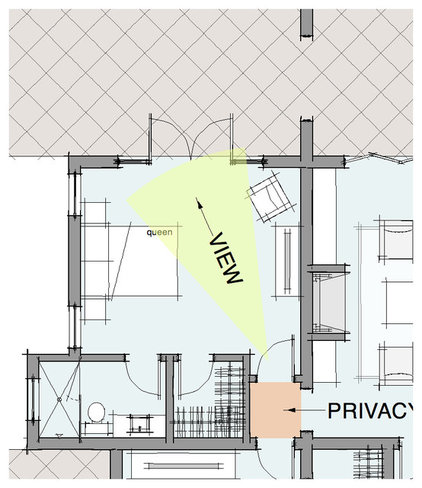http://www.houzz.com/ideabooks/18311359/list/7-Tips-for-Designing-Your-Bedroom
Because the bedroom is one of the simplest rooms in the house, it's often overlooked. One of the first steps to a great bedroom design is having an efficient and well-designed floor plan that gives you everything you want — no matter how much space you start with.
Here are seven tips to help you get the most out of your bedroom.
Here are seven tips to help you get the most out of your bedroom.
1. Simple circulation. Try to keep your circulation on one side of the room. Hotels do a great job of this. There's a reason 90 percent of hotels have the same floor plan: because it's simple and it works.
Circulation plans become a little more challenging with en suite rooms (bedrooms with bathrooms attached) or bedrooms that have doors to the outside.
Circulation plans become a little more challenging with en suite rooms (bedrooms with bathrooms attached) or bedrooms that have doors to the outside.
To save on space, pay attention to where you locate the bathroom and closet in your bedroom. Rooms that have bathroom or closet access before the sleeping area require a longer hall (see the left-hand plan). If you organize the circulation so the bathroom and closet are accessed through the sleeping area (right-hand plan), you don't need a separate hall, and you can add the circulation space into the room to make it feel larger, too.
2. Focus on the view. A bedroom always feels nicer when the first thing you experience is a pleasant view out the window — as opposed to a view looking straight at the bed. If you're designing a new bedroom or reworking an old one, try to come up with a layout that focuses on the vista — whether it's something as stunning as a lake or as simple as your backyard.
3. Keep privacy in mind. It's always nice when you can leave the bedroom door open without forsaking all of your privacy. The small foyer in this example provides separation from the family room. I always try to avoid designing a layout in which you look directly into the bedroom from a more public space, like a great room, kitchen or family room.
4. Connect with the outdoors. While this might not be feasible in all climates, connecting a room with the outdoors is a great way to make the space feel larger and admit more natural light. If your bedroom is on the ground floor (or is on the second story and has an adjacent terrace), adding a set of French doors can instantly increase visual space.
5. Consider the furniture layout. Your bedroom's architecture should take your furniture into account. Bedroom floor plans usually have a bed wall — but what about dressers, nightstands, TVs, chairs and a desk? Work with your architect or designer to make sure there is enough space beside the bed for nightstands and ample circulation so you can access three sides of the mattress.
6. Increase light and ventilation. Locating your bedroom at the corner of your home can give you windows on two or more adjacent walls. This gives you the added benefit of cross ventilation and a softer natural light.
7. Take your time. Great design takes a while and usually requires refining before you come up with the perfect plan for your lifestyle. Don't rush through the design — it's worth taking a little extra time up front to make sure you have a more efficient and functional plan in the end.
The truth is, great design doesn't necessarily mean a space that's overly complex and expensive to build. A space that functions better, costs less to build, is more efficient to run and is easier to maintain can be an outstanding example of great design.











No comments:
Post a Comment